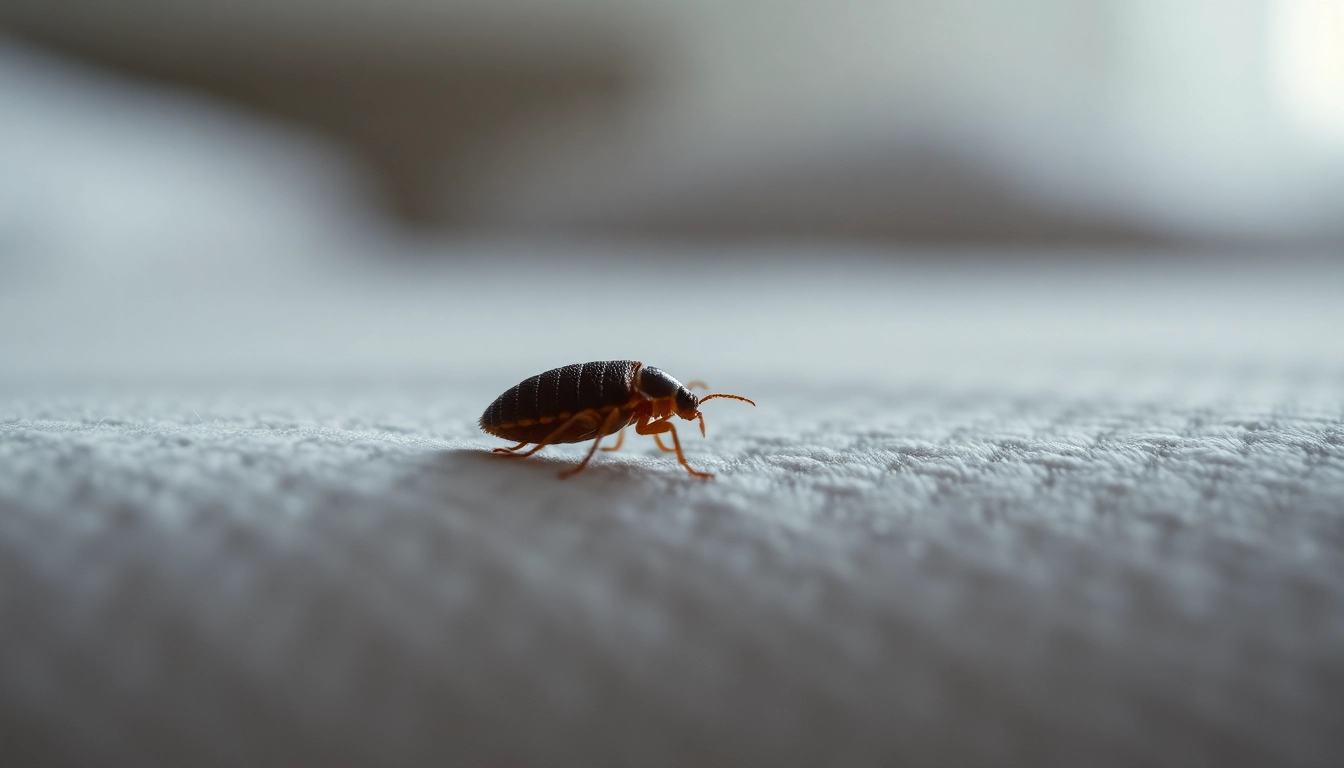Understanding Bed Bugs: Identification and Behavior
What Are Bed Bugs?
Bed bugs, scientifically known as Cimex lectularius, are nocturnal insects that primarily feed on human blood. These tiny, reddish-brown pests can be as small as a pinhead to about the size of an apple seed when fully grown. Bed bugs are resilient creatures; infesting even the cleanest of homes and apartments. They are known for their ability to reproduce rapidly—females can lay up to five eggs per day, leading to explosive population growth in a short amount of time.
Signs of Infestation
- Physical Bites: Bed bug bites are usually red, itchy welts that appear in clusters or rows on the skin, often in areas that are exposed during sleep.
- Blood Stains: Small blood stains on bedding or mattresses can indicate bed bugs have fed on a host and subsequently crushed during movement.
- Dark Spots: Fecal spots, which appear as dark, small specks on surfaces where bed bugs reside, can also signal a presence.
- Shedding Skins: Bed bugs molt as they grow, leaving behind empty exoskeletons that can be found in their hiding places.
How Bed Bugs Spread
Understanding how bed bugs spread is crucial for effective control. They usually hitch a ride on luggage, furniture, clothing, and bedding, making their way into new environments. Their ability to hide in tiny crevices allows them to be transported without detection, exacerbating infestations in hotels, apartments, and boarding houses. Controlling this spread is an essential aspect of Bed Bug Control, requiring diligence in monitoring high-risk areas.
Essential Techniques for Bed Bug Control
Non-Chemical Control Methods
Employing non-chemical methods can be an effective first step in controlling bed bug populations. Here are some techniques to consider:
- Heat Treatment: Bed bugs are highly susceptible to heat. Washing infested items in hot water and drying them on the highest setting can eliminate not only bugs but their eggs as well. Alternatively, steam cleaning infested areas can effectively treat carpets and upholstered furniture.
- Freezing: Placing items in a freezer at 0°F (-18°C) for at least four days helps eliminate bed bugs. This method is particularly useful for smaller items that cannot be washed.
- Decluttering: Reducing clutter around the home minimizes hiding spots for bed bugs, making it easier to identify and treat infestations.
- Vacuuming: Frequent vacuuming of floors, carpets, and furniture can significantly reduce bed bug populations. Be sure to dispose of vacuum contents in a sealed bag immediately afterward.
Chemical Treatments Overview
Chemicals can serve as a vital component in a comprehensive bed bug control strategy, especially for severe infestations. Various pesticides are available, and it’s essential to choose products specifically designed for bed bugs. Here’s a breakdown of typical chemical treatments:
- Residual Insecticides: These are applied to surfaces where bed bugs may walk. They remain effective for several weeks and can kill newly emerged bed bugs.
- Insect Growth Regulators (IGRs): IGRs disrupt the life cycle of bed bugs, preventing them from maturing or reproducing, which can help reduce their numbers over time.
- Multi-Purpose Sprays: These are formulated to quickly kill bed bugs on contact. Such products can be effective in combination with other control methods.
Integrated Pest Management (IPM) Approach
The Integrated Pest Management (IPM) approach is a holistic strategy that combines multiple methods to manage pest issues effectively. The steps involve:
- Monitoring: Regular inspections help to identify infestations and monitor their progress.
- Identification: Correctly identifying the pest is essential for selecting the appropriate control methods.
- Prevention: Implementing measures such as sealing cracks, regular cleaning, and reducing clutter will deter entry and habitat for bed bugs.
- Control: Utilizing a combination of chemical and non-chemical methods ensures pest populations are effectively managed.
Do-It-Yourself Bed Bug Treatment Tips
Preparing Your Home for Treatment
Before embarking on a DIY treatment for bed bugs, it’s vital to prepare your home appropriately. This preparation includes:
- Decluttering: Clear out spaces to make areas easier to treat.
- Washing Fabrics: Wash all bedding, clothing, and linens in hot water.
- Removing Furniture: Move furniture away from walls to expose potential hiding places.
- Sealing Cracks and Gaps: Use caulk to seal potential entry points where bed bugs can hide.
Effective DIY Remedies
Although they may not be as effective as professional treatments, several DIY remedies can help reduce bed bug populations:
- Diatomaceous Earth: This natural powder can be sprinkled in areas where bed bugs are suspected. It dehydrates and kills them upon contact.
- Essential Oils: Certain essential oils, such as tea tree oil or lavender oil, have been reported to repel bed bugs; however, they should not be solely relied upon for eradication.
- Alcohol Sprays: Rubbing alcohol can kill bed bugs on contact, although it won’t provide long-lasting protection.
Safety Precautions During Treatment
Safety is paramount when conducting DIY treatments for bed bugs. Always follow these precautions:
- Wear gloves and a mask when handling chemical products.
- Avoid mixing chemicals unless explicitly directed, as reactions can be harmful.
- Follow the manufacturer’s instructions for any products used and ensure proper ventilation.
- Keep children and pets away from treated areas until they are deemed safe.
Professional Bed Bug Control Services
When to Call an Exterminator
While DIY methods can be effective for minor infestations, there are instances when calling in the professionals is the best option. Consider contacting an exterminator when:
- The infestation is widespread and significantly impacting quality of life.
- DIY attempts have been unsuccessful over time and require immediate intervention.
- Expert knowledge and specialized equipment are needed to combat a robust bed bug population.
What to Expect from a Pest Control Service
When hiring professional pest control services, you can typically expect the following process:
- Consultation: An initial inspection to assess the extent of the infestation and discuss treatment options.
- Treatment Plan: Providing a detailed plan including methods to be used and duration.
- Follow-Up Visits: Often, multiple treatments are necessary, so follow-up visits will be scheduled to ensure effectiveness.
Choosing the Right Exterminator
To find the right exterminator for your needs, consider the following tips:
- Check for licensing and certifications relevant to pest control.
- Look for customer reviews and testimonials to gauge the company’s effectiveness and reliability.
- Ask about the methods and products used, ensuring they align with your comfort level regarding health and safety.
- Inquire about guarantees or warranties that offer peace of mind in case the bugs return.
Preventing Future Infestations
Best Practices for Bed Bug Prevention
Implementing preventive measures is crucial to avoiding future infestations. Here are some best practices:
- Regular Inspections: Frequently inspect your home, especially after traveling or purchasing used furniture.
- Protective Covers: Use mattress and pillow encasements specifically made to keep bed bugs out.
- Mindful Travel Habits: Always check hotel rooms for signs of bed bugs and keep luggage off the floor.
Regular Maintenance and Inspections
In addition to the best practices for prevention, regular maintenance and inspections can safeguard your home against bed bugs:
- Conduct routine checks around beds and furniture, looking for signs of bed bugs.
- Enlist pest control professionals for periodic inspections, especially if you live in a high-risk area.
Raising Awareness in Your Community
Community awareness plays a vital role in controlling bed bug outbreaks. Here’s how you can contribute:
- Engage in community initiatives aimed at educating residents about bed bugs.
- Promote local resources for pest control and guidance among friends and neighbors.
- Encourage landlords and property managers to address pest management openly.



